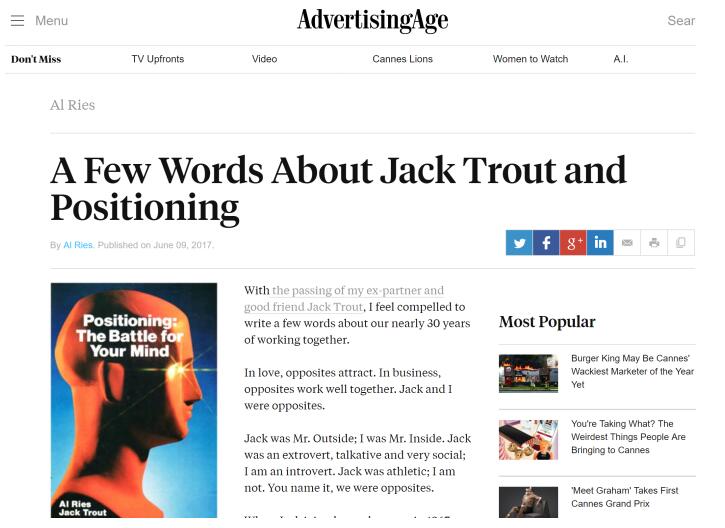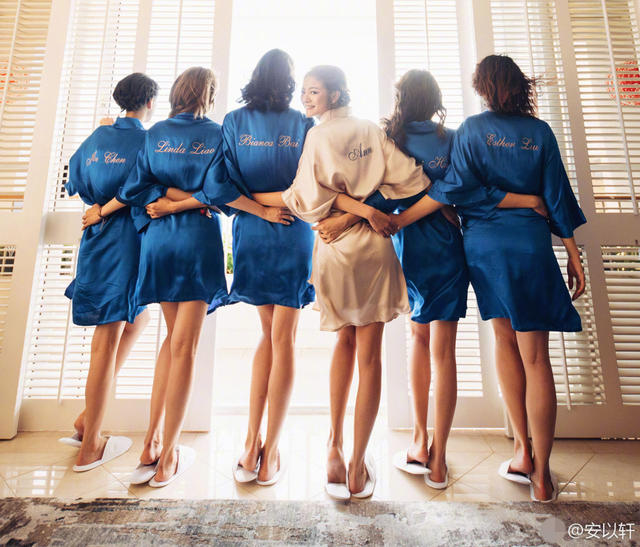By Al Ries. Published on June 09,2017
艾·里斯,于2017年6月9日。
导语:
杰克·特劳特先生前合伙人——艾·里斯先生近日在《广告时代》 (Advertising Age )发表文章,回顾二人过去将近30年共事的时光,并重申定位原则。
一位英语八级的定位爱好者特别将艾·里斯先生原文进行了翻译,并提供中英文对照的版本,投稿给定位学习网。
现在我们将全文刊发,让定位爱好者可以更直观地感受两位定位大师的风采……

With the passing of my ex-partner and good friend Jack Trout, I feel compelled to write a few words about our nearly 30 years of working together.
在我的前合伙人及好友杰克·特劳特去世之际,我感到有必要写些话,谈一谈我们近三十年的合作经历。
In love, opposites attract. In business, opposites work well together. Jack and I were opposites.
在爱情里,异性相吸,在商业中,截然相反的人合作良好。杰克和我是截然不同的人。
Jack was Mr. Outside; I was Mr. Inside. Jack was an extrovert, talkative and very social; I am an introvert. Jack was athletic; I am not. You name it, we were opposites.
杰克负责对外,我负责对内。杰克性格外向、健谈、善于社交,而我是个内向的人。杰克有运动天赋,我则没有。你看,我们是十分相反的人。
When Jack joined my ad agency in 1967, advertising was widely considered to be "communications."
当杰克1967年加入我的广告公司时,广告在业内还普遍被视作“沟通工具”。
You studied your product, its features and its competitors and then you prepared advertising that explained why your product was better.
你研究你的产品,包括其产品特点和竞争对手,再准备做广告来解释为什么你的产品更好。
In spite of billions of advertising dollars spent every year, perceptions about leading brands as well as their market shares seldom changed. All that advertising was not doing very much communicating.
尽管各行业每年有数十亿美元的广告投放,但行业领导品牌的认知优势和市场份额却鲜有动摇。广告并没有真正起到沟通的作用。
That insight led to the positioning concept. Instead of focusing on the product and its competitors, we focused on the mind of the prospect. And in the process, we developed the principles of positioning.
基于这样的洞察,定位的概念应运而生。我们关注于顾客心智,而不是产品和竞争对手。在这个过程中,我们发展了定位的几点原则。
(1) The concept of categories.
(1)品类的概念
With a billion neurons and some 2.3-trillion connections, the human mind is a massive mental storage container. From a marketing point of view, however, the most-important aspect of the mind is the concept of categories.
人类大脑是一个庞大的储藏箱,由10亿个神经元和2.3万亿个连接组成。然而,从营销的角度看,心智中最重要的是品类的概念。
Consumers use categories to store brands that interest them. When consumers want to buy something, they think category first, brand second.
顾客用品类来存储他们感兴趣的品牌。当顾客要买东西时,首先想到品类,其次才是品牌。
Nobody walks into a store and says: I want to buy a Sony. Please show me all the Sonies you have for sale.
不会有人走进商店说:我想买台索尼,请给我看看店里所有的索尼。
(2) For every category, there is a ladder in the mind.
(2)每个品类都有心智阶梯
On the rungs of the ladder are brand names, with the preferred brand at the top of the ladder and the rest of the brands in descending order.
心智阶梯的每一层上是品牌的名字,最受欢迎的品牌在顶层,其他品牌依次降序排列。
Most consumers have room in their minds for only a few brands in each category. Many categories have just two brands. Duracell and Energizer in appliance batteries.Crest and Colgate in toothpaste.
在顾客心智中,每个品类仅能存储少数品牌。许多品类只能存储两个品牌,如电池里的金霸王和劲量,牙膏中的佳洁士和高露洁。
Seldom do consumers consider their top two brands as equals. Invariably, consumers prefer one brand over the other, although the second brand is often "acceptable."
并且,排名前两位的品牌很少被顾客同等对待。顾客总是更青睐其中一个品牌,尽管另一个品牌通常也是“可接受的”。
(3) The name is the hook that hangs the brand on the ladder.
(3)品牌名是钩子,将品牌挂在心智阶梯上
The most important marketing decision you can make is what to name the product. That's what we said in our 1981 book "Positioning."
你能做的最重要的营销决策就是给产品命名。这是我们在1981年出版的《定位》中所说的。
The leading vodka brand in Russia is Kremlyovskaya. So the owners of the brand introduced Kremlyovskaya in the American market with the slogan, The No.1 vodka brand in Russia.
在俄罗斯,伏特加的领导品牌是Kremlyovskaya。因此,这个企业在美国市场推出Kremlyovskaya时用的广告语是,俄罗斯伏特加第一品牌。
Naturally, the brand went nowhere. How can an English-speaking person file that name in the vodka category in the mind?
不用说,这个品牌在美国没有激起丝毫水花。你怎么能要求一个说英语的人把那个复杂难读的俄罗斯名字在心智的伏特加品类里存档呢?
The leading pasta brand in Italy is Barilla. So the owners of the brand introduced Barilla in the American market with the slogan, Italy's #1 pasta. Three years later, Barilla was the No.1 pasta brand in America.
在意大利,通心粉的领导品牌是Barilla。在打开美国市场时,企业用的广告语是:意大利排名第一的通心粉。三年后,Barilla成为美国通心粉第一品牌。
(I made several speeches in Moscow suggesting that Kremlyovskaya in America be called Red Square Vodka.)
(我曾多次在莫斯科演讲时建议,Kremlyovskaya应将它在美国的名字改成Red Square伏特加。)
(4) Find an open hole in the mind.
(4)找到心智空位
Every category in the mind is either filled with a brand name, or it's not. If the category is not filled, then it's an open hole or position which your brand can easily occupy.
在心智中,品类要么被品牌名占据,要么虚位以待。如果一个品类还未被占据,那么它就是个空位,你的品牌容易占据它。
Tesla moved into the mind to occupy an open category called "electric cars." Today, Tesla is worth more on the stock market ($61 billion) than either General Motors ($52 billion) or Ford ($44 billion.)
特斯拉进入心智占据了“电动汽车”这一存在空位的品类。今天,特斯拉的市值高达610亿美元,超过通用汽车(520亿美元)和福特(440亿美元)。
But didn't General Motors, Ford and every other major automobile company in the world also introduce electric vehicles? Sure, but they didn't give them different brand names so consumers had no way of filing these names in their minds.
但是,难道通用、福特和其他主要汽车厂商没有推出电动车吗?当然有,但他们没有给电动车新的品牌名,所以顾客没法将其在心智中归类。
You can’t put "Chevrolet" on your electric-car ladder.
你无法把“雪佛兰”放在电动车的心智阶梯上。
(5) Touch base with what's already in the mind.
(5)与心智中的既有认知相关联
Advertising a minor feature of your brand that is already recognized in prospects' minds is a better strategy than advertising a major feature of your brand nobody knows about.
传播一个顾客心智中已有的但是较小的品牌特点,与传播一个重要但却在顾客心智中毫无认知的特点相比,前者效果更好。
Yet most companies do exactly the opposite. No sense advertising what people already know, let's use our advertising to communicate what they don't know.
然而,大多数公司反其道而行之。他们认为传播人们已经知道的内容没有意义,要用广告来传达顾客不知道的东西。
Thanks to its invention of the lap-and-shoulder seat belt, Volvo was known for safety. As a result, Volvo was the leading imported luxury-vehicle brand in the American market from 1978 to 1992. But that wasn't good enough for Volvo.
由于发明了斜拉三点式安全带,沃尔沃汽车以安全闻名。其结果是,在1978至1992年间沃尔沃成为美国市场上领先的进口豪华车品牌。但这对沃尔沃来说还不够好。
As the global advertising manager said, Safety on its own is not enough. So Volvo introduced a range of vehicles including convertibles and the C30 hatchback with a turbo-charged engine. (Automotive News called it a "pocket rocket for the kids.")
沃尔沃的全球广告经理说,仅靠“安全”是不够的。因此,沃尔沃推出了一系列车型,包括敞篷车和使用涡轮增压发动机的掀背车C30(被《汽车新闻》称为“孩子们的袖珍火箭”)。
And Volvo advertising talked about beauty and performance with various themes including Life is better lived together.
除此之外,沃尔沃的广告还谈及外观、性能等各种主题,包括共同生活更美好等。
Last year, the leading imported luxury-vehicle brands were Mercedes, Lexus, BMW, Audi, Acura, Infiniti. And then Volvo.
去年,领先的进口豪华车品牌是梅赛德斯、雷克萨斯、宝马、奥迪、讴歌、英菲尼迪,之后才是沃尔沃。
(6) You can't move a brand in the mind.
(6)你无法移动心智中的品牌
Many billions have been wasted by companies that violate this positioning principle. IBM trying to move its brand into personal computers.Kodak trying to move its brand into digital photography.BlackBerry trying to move its brand into touchscreen smartphones.
数以亿计的大量资源被违反这一定位原则的企业浪费掉了。IBM试图让品牌进入个人电脑领域,柯达试图让品牌进入数码摄影领域,黑莓试图让品牌进入触屏智能手机领域。
The list is endless. We called this exercise in futility, The line-extension trap.
这种例子不胜枚举,我们称这种无效动作为“品牌延伸陷阱”。
(7) Initials don't exist in the mind.
(7)首字母缩写名称不存在于心智中
There are letters of the alphabet and there are words in the mind, but not initials. When a mind hears or reads about a brand using initials, the instant reaction is "What do those initials stand for?"
字母表中有字母,心智中有由字母组成的词汇,但没有首字母缩写。当顾客心智听到或看到品牌的首字母缩写名称,他会下意识地想“这些首字母缩写代表什么?”
GE stands for General Electric. HP stands for Hewlett-Packard. IBM stands for International Business Machines. Initials are recognized in the mind not as initials, but as the shorthand for names. If the names are not in the mind, then the prospect is unlikely to remember the initials.
GE代表General Electric(通用电气),HP代表Hewlett-Packard(惠普),IBM代表International Business Machines(国际商业机器)。首字母缩写在心智中并非被认知为缩写本身,而是缩略了的全名。如果全名没有进入心智,那么它的缩写很难进入心智。
And yet, there is a strong trend toward initials. Do you recognize any of these 30 no-name companies? HCA, CHS, TJX, EMC, PNC, AES, NRG, PBF, CDW, VF, CSX, CBRE, BBGT, DTE, CST, EDG, PVH, KKR, PPL, AGCO, LKQ, AK, UGI, CMS, WEC, HRG, CH2M, SGP, LAM and NVR.
然而,人们热衷于使用首字母缩写。你认识这30个无名公司吗?HCA、CHS、 TJX、EMC、PNC、AES、NRG、PBF、CDW、VF、CSX、CBRE、BBGT、DTE、CST、EDG、PVH、KKR、PPL、AGCO、LKQ、AK、UGI、CMS、WEC、HRG、CH2M、SGP、LAM和NVR。
Probably not. But all 30 are on Fortune's latest list of the 500 largest American companies. The smallest, NVR, had revenues last year of $5.2 billion, enough money to hire a marketing-strategy firm.
可能不认识,但这30家都是美国《财富》五百强企业,其中最小的企业NVR去年营收52亿美元,有足够的钱去聘请一家营销战略公司了。
(8) A slogan or a tagline is not a position.
(8)广告语或标语不是定位。
Almost every company in the world uses either a slogan or a tagline. Yet almost none of these slogans or taglines are what Jack or I would have called a "position."
世界上几乎每家企业都有广告语或标语,但几乎没有一个广告语或标语是杰克和我所说的“定位”。
A position is something that exists in the mind. Most slogans or taglines are "aspirational." With enough advertising, they hope to be inserted into prospects' minds. It seldom happens.
定位是已经存在于心智的东西,而大多数的广告语或标语是企业的抱负与期望,并希望通过足够大的广告量而进入心智。这样的希望鲜有实现。
Take Nissan's slogan Innovation that excites. Does Nissan really think potential car buyers have has an open hole in their minds called "Exciting automobile innovations."
例如,日产汽车的广告语是“激动人心的创新”。日产公司真的认为潜在顾客的心智中有个空位叫做“激动人心的汽车创新”吗?
Safety is a position. Driving is a position. Inexpensive is a position. Small is a position. But Exciting automobile innovations is not.
安全是个定位,驾驶是个定位,低价是个定位,小型是个定位,但激动人心的汽车创新不是。
There's still a lot of work to be done.
未来还有很长的路要走。
And without Jack Trout, it is going to be a lot more difficult to move the positioning concept into the minds of business executives around the world.
没有了杰克·特劳特,要让定位观念进入全球企业管理者的心智变得困难得多。
But with my daughter Laura Ries, I will keep trying.
但与我的女儿劳拉·里斯一起,我将继续努力。












